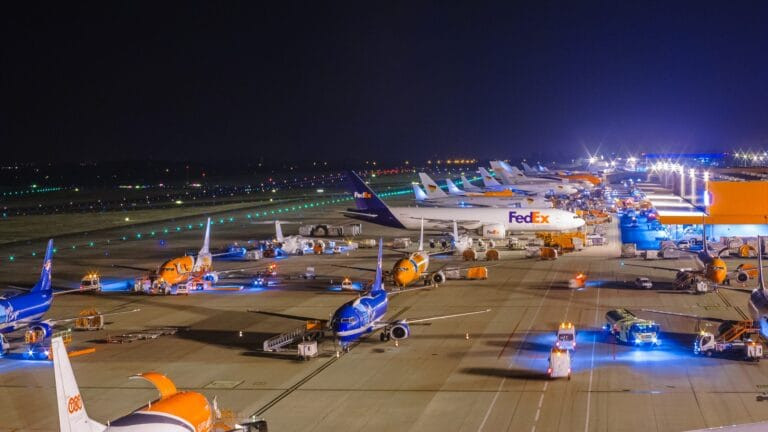Liege Airport’s new initiative—Cargoland—is a declaration that cargo is not an afterthought, but the main attraction. This isn’t a branding gimmick; it’s a full-scale commitment to transform the perception, infrastructure, and execution of airfreight in Europe and beyond.
“Cargoland is our new commercial branding of all our cargo activities,” says Torsten Wefers, vice president of sales and marketing at Liège Airport. “I once said in an interview, we are the Disneyland of air cargo. Obviously, the brand Disneyland was a bit difficult for us to get. So we transformed into Cargoland. Cargoland, for us, is where cargo has a home.”
Liège Airport’s air cargo-first philosophy runs deep. While many airports prioritise passengers, Liège has built its identity on being “the airport in Europe where air cargo has a home.” And that home comes with more than just metaphorical magic—it’s a purpose-built platform, complete with 24/7 operations, specialised handling for pharmaceuticals and perishables, and even a five-star hotel for horses.
“We give it a full shine,” Wefers explains. “We give cargo a home. And this is the idea—to explain the importance of air cargo at Liège Airport and for the entire air cargo community.”
Their central location in the heart of Europe is no accident either. “We are really in this famous triangle where 80 percent of the European air cargo imports and exports are going through,” Wefers says. “We have full flexibility—24/7—a perfect infrastructure. And of course, we have this unique air cargo-only approach.”
Digital transformation is at the core of Liège’s cargo strategy. The airport is building a digital twin of its infrastructure to increase efficiency, reduce processing time, and streamline critical logistics operations.
“We are developing a digital twin of our airport infrastructure to speed up the processes, to improve the handling quality—and all this for the benefit of our customers: the cargo airlines and the forwarders.”
Multimodal might
But Liège Airport isn’t stopping at planes. To be truly indispensable in the global supply chain, it’s becoming a multimodal hub—leveraging rail, road, and even inland waterway access to enhance its connectivity and appeal to logistics companies.
“We have developed now certain applications where we can track all the flows going via Liège Airport,” says Wefers. “So the idea is now to create a customs zone around the Liège Airport that is fully supported by the digital twin, so that Customs also has full visibility of all flows.”
That real-time visibility goes hand in hand with infrastructure investments. Liège has acquired a stake in its on-site rail operator, allowing the airport to directly influence and integrate inbound cargo trains from as far as China. And road freight? That’s very much in play too.
“We have bought a stake in the operator of the train platform, to have a commercial influence there… to make it even more attractive for logistics companies—not only for air cargo, but also to use Liège Airport as a platform for train cargo,” he explains. “We want to move even more truck cargo volumes via our airport platform.”
There’s even a waterway connection many don’t realise exists. “The Port of Liège is the third biggest inland port in Europe, and is directly connected with Europe’s major seaport, Antwerp,” says Wefers. “Also something that a lot of people do not know. The area of the port is also included in the LGG customs area. So that also means a fourth mode of transport—we can also add sea cargo to this portfolio.”
Community-driven, commodity-focused
For Liège Airport, collaboration is as critical as infrastructure. Recognising that an effective supply chain is only as strong as its weakest link, Wefers and his team launched LGG Connect, a non-profit cargo community that brings together all key players—airlines, forwarders, handlers, and trucking companies.
“Since ever, we had a very strong informal community,” Wefers explains. “Two years ago, we decided to formalise the cargo community… All the founding community members have a share, and also a board seat.”
The goal? Equality, transparency, and empowerment. “We are setting up working groups on comparable development, on infrastructure development, on how to bring up the quality. And via the community approach—everyone has an equal standing, everyone has an equal voice.”
That collaborative framework extends to Liège’s work in expanding and enhancing its commodity handling capabilities. From e-commerce to pharmaceuticals, perishables, and even automotive parts, the airport is constantly upgrading and standardising its approach.
“We are the market leader in e-commerce. Nevertheless, of course, we want to have a bigger market share,” Wefers says. “So again, we are putting a lot of effort via digital tools to speed up the processes and improve handling quality.”
“Lately, we also launched the pharma community,” he continues. “The airport, the handling agents, the airlines, and the forwarders are sitting together. The clear goal is to have standard processes, standard SLAs, and also to work on infrastructure jointly.”
The Horse Inn—Liège’s dedicated, luxury animal transit facility—remains one of the more niche but globally renowned aspects of its operation. “The horses you mentioned—that’s a niche, but for us, a very important niche. Last year, we handled more than 12,000 horses. This we want to further develop.”
Green ambition meets efficiency
Sustainability is woven into the DNA of Liège’s development strategy, Wefers stresses. With a goal of carbon neutrality by 2030, the airport is taking a wide-angle approach to reduce its environmental impact across all activities.
“With our own activities, we want to be carbon zero in 2030,” Wefers confirms. “We are part of certain programmes and certifications—for example, the TIACA BlueSky programme—where we already reached a certain certification.”
Real estate, too, is being rethought. “We are developing our own real estate—office buildings, warehouses, and even our own kindergarten for our airport community. Clearly, we are looking for green buildings.”
On the apron, the transformation is already under way. “We are working very closely with our handling agent to change the GSE fleet to a full E-fleet,” he says. “We are encouraging our handlers, and we are even supporting them with loading infrastructure. There is a clear goal—by the end of the decade, to have the entire GSE fleet at Liège Airport fully electric.”
One of the most impactful moves, however, is in sustainable fuel. Liège is among Europe’s first airports to offer SAF (sustainable aviation fuel), with the first SAF-powered flights already operational. “We already had the first flights that were operated with SAF fuel,” Wefers confirms. “It’s just the beginning.”





